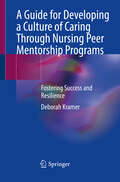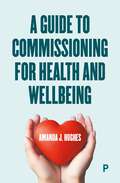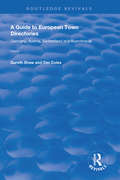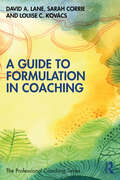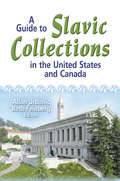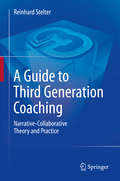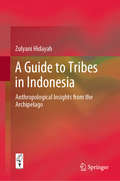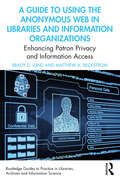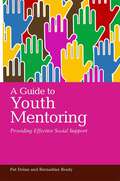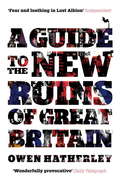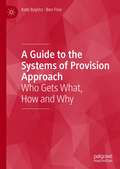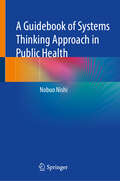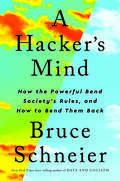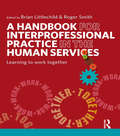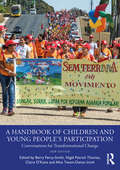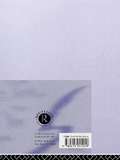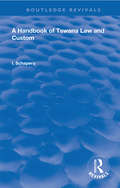- Table View
- List View
A Guidance Approach for the Encouraging Classroom
by Dan GartrellA GUIDANCE APPROACH FOR THE ENCOURAGING CLASSROOM, 5/E, is for students in two- and four-year early childhood programs as well as graduate courses. It easily can function as a primary text in classes that address group management, the learning environment, child guidance, child behavior, challenging behavior, conflict management, and peace education topics. The text addresses ages 3 - 8 years in three parts. Part 1 explores the foundation of guidance in early childhood education and covers key concepts such as conventional discipline versus guidance, mistaken behavior, the guidance tradition, and innovative theories about child development with guidance. Part 2 focuses on building and organizing an encouraging classroom, as well as providing key elements of an encouraging classroom, including daily schedule, routines, use of thematic instruction, importance of working with parents, and leadership communication. Part 3 addresses problem solving and challenging behavior in the encouraging classroom, including a practical illustration for how to use and teach conflict management and coverage of the five-finger-formula. The book also covers nontraditional families as well as the effects of societal violence in the classroom. Throughout, this experience-based resource includes real-life anecdotes that allow professionals to make the shift from conventional classroom to developmentally appropriate guidance.
A Guide To U.S. Aircraft Noise Regulatory Policy (Springerbriefs In Applied Sciences And Technology Ser.)
by Sanford Fidell Vincent MestreAviation noise remains the primary hindrance to expansion of airport and airspace capacity in the United States. This book describes the development and practice of U.S. aircraft noise regulation, as well as the practical consequences of regulatory policy. Starting in the pre-jet transport era, the book traces the development of the modern framework for characterizing, standardizing, predicting, disclosing, and mitigating aircraft noise and its effects on airport-vicinity communities. Among other matters, the book treats noise-related consequences of the 1978 deregulation of the airline industry; prediction and mitigation of community reaction to airport noise; land use compatibility planning; recent research and industry trends; and some suggestions for potential improvements to current policy. Initial chapters describe the assumptions underlying aircraft noise regulation, and lay out the chronology of U.S. aircraft noise regulatory practice. Later chapters provide overviews of population-level effects of aviation noise, including health effects, speech and sleep interference, and annoyance. Readers will learn why predictions of the prevalence of aircraft noise-induced annoyance have systematically underestimated adverse community response to aircraft noise, and how such underestimation has complicated approval and funding of airport and airspace improvement projects. They will also learn why attempts at noise-compatible land use planning are seldom fully successful.
A Guide for Developing a Culture of Caring Through Nursing Peer Mentorship Programs: Fostering Success and Resilience
by Deborah KramerThis book describes in detail how to develop successful programs of nursing mentorship, utilizing concepts of caring that yields a strong, caring body of nurses who will be “nurse thrivers” as they find fulfilment and meaning in their professional commitment and will train others to do the same. The mentorship program is the ticket to success that many students need to complete their degree program, prevent burnout, pass the nursing NCLEX examination, and remain in the workforce after graduation. The current attrition rate in baccalaureate nursing programs is 25-50%, as is the attrition rate in the first 2 years of employment of new RN's entering the workforce. Burnout is due to a lack of care and support for helping the students navigate the rigor and demands of the nursing program. Creating a community of learners with caring and support creates an environment that fosters academic engagement and success. The unique aspect of this book is its focus on creating a caring environment to support the students; helping them develop caring skills, empathy, resilience and their own self-care; developing the skills for success beyond their educational process into the workforce. This book integrates all patterns of knowing - personal, aesthetic, empiric and ethical - and provides the missing link of peer mentorship necessary to the development of resilient, emancipated nursing students and graduates capable of working in community with others to establish cultures of care in health care. This is a must have resource for transformation of nursing education in the next century! Foreword by Dr. Margaret McClure.
A Guide to Children's Reference Books and Multimedia Material (Routledge Revivals)
by Susan HancockFirst published in 1998 , A Guide to Children’s Reference Books and Multi Material provides essential information on over 250 children’s reference products for parents, teachers and librarians wishing to purchase the best books and multimedia material in the late 90’s.
A Guide to Commissioning Health and Wellbeing Services
by Amanda J. HughesAre you a health and social care commissioner navigating the ever-changing commissioning landscape? With challenges such as limited funding, changing demands and global pandemics, we need to be clear on why, what and how we commission effectively. This book offers you a warm welcome into the often-complex world of healthcare commissioning. Amanda J. Hughes shares personal insights from her commissioning career and practical guidance that will demystify the commissioning cycle and ease the journey as you strive to achieve the best outcomes for the population. This book will help you to ensure valuable resources are directed to those with most need, that care is fair and accessible and that the solutions you put into place are sustainable for the longer term.
A Guide to European Town Directories: Volume One - Germany, Austria, Switzerland and Scandinavia. (Routledge Revivals)
by Gareth Shaw Tim ColesFirst published in 1997, European Directories is a major resource guide for urban historians and historical geographers. It provides a detailed bibliography of all directories published and available in major libraries throughout Germany, Austria, Switzerland, Denmark and Scandinavia. In addition, the book provides an account of the evolution of town directories, as well as giving an analysis of directory reliability and coverage. Researchers will also find an extensive bibliography for each country of literature that has utilized directory information in historical studies. The second volume includes France and southern Europe. The whole provides the first European-wide resource for those undertaking urban historical studies.
A Guide to Formulation in Coaching (The Professional Coaching Series)
by Sarah Corrie David A. Lane Louise C. KovácsLane, Corrie and Kovács present a foundational text for coaches wishing to improve their coaching practice through use of formulation.A Guide to Formulation in Coaching examines the nature and purpose of formulation and how to develop effective formulations that can inform and improve practice. It combines theoretical perspectives with case studies illustrating its use in different coaching contexts to provide a comprehensive and accessible account of the purpose, perspectives and processes used in formulation. In addition to providing practice-based examples and drawing on the literature, the book provides a series of exercises to enable readers to refine their individual approaches.Practical and accessibly written, this book will be a valuable resource for coaches and coaching psychologists, coaching supervisors and trainers, and academics interested in understanding the role of formulation and how it applies in a coaching context.
A Guide to R for Social and Behavioral Science Statistics
by Brian Joseph Gillespie Dr. William E. Wagner Kathleen Charli HibbertA Guide to R for Social and Behavioral Science Statistics is a short, accessible book for learning R, geared toward social and behavioral science students. Instructors Brian Gillespie, Kathleen Hibbert, and William E. Wagner, III, have combined a review of introductory statistics with an introduction to R to teach readers two of the most valuable skills for research and in the workplace. Designed for readers with no knowledge of statistics or R, A Guide to R for Social and Behavioral Science Statistics follows the most common progression of statistics, starting with basic descriptive statistics, and continuing up through inferential statistics and regression. This text provides step-by-step instructions for working with R, starting with downloading and installing R and RStudio®, featuring code and output so readers can follow along with each step. Readers can apply their knowledge with examples and exercises featuring data from the General Social Survey in each chapter. Tips on R show users how to avoid common pitfalls in R and most efficiently use the RStudio interface. With frequent reminders of statistical concepts to accompany instructions and tips in R, this text helps readers master R for statistics in the social and behavioral sciences.
A Guide to R for Social and Behavioral Science Statistics
by Brian Joseph Gillespie Dr. William E. Wagner Kathleen Charli HibbertA Guide to R for Social and Behavioral Science Statistics is a short, accessible book for learning R, geared toward social and behavioral science students. Instructors Brian Gillespie, Kathleen Hibbert, and William E. Wagner, III, have combined a review of introductory statistics with an introduction to R to teach readers two of the most valuable skills for research and in the workplace. Designed for readers with no knowledge of statistics or R, A Guide to R for Social and Behavioral Science Statistics follows the most common progression of statistics, starting with basic descriptive statistics, and continuing up through inferential statistics and regression. This text provides step-by-step instructions for working with R, starting with downloading and installing R and RStudio®, featuring code and output so readers can follow along with each step. Readers can apply their knowledge with examples and exercises featuring data from the General Social Survey in each chapter. Tips on R show users how to avoid common pitfalls in R and most efficiently use the RStudio interface. With frequent reminders of statistical concepts to accompany instructions and tips in R, this text helps readers master R for statistics in the social and behavioral sciences.
A Guide to Slavic Collections in the United States and Canada
by Allan Urbanic Beth FeinbergGet access to the Slavic and East European research materials you needA Guide to Slavic Collections in the United States and Canada presents up-to-date information on 85 North American libraries that house Slavic and East European research materials, providing current details on recent acquisitions, developments in collection policies, and changes in contact information. Using individual entries written by each institution&’s librarian or archivist, you&’ll save valuable time and effort in your search for resources on Russia and the rest of the former Soviet Union, Poland, the Czech and Slovak Republics, the former Yugoslavia, the Baltic countries, Bulgaria, Albania, Hungary, Romania, and the Sorbs in Germany. This unique book includes facts and figures on special collections, finding aids, catalogs, Web access, and bibliographies for further readings.A Guide to Slavic Collections in the United States and Canada examines collections available at public libraries, governmental libraries, special collections, and university libraries. Edited by Dr. Allan Urbanic, Librarian for Slavic and East European Collections at the University of California, Berkeley, and Slavic Collection Manager at the University of California, Santa Barbara, and Beth Feinberg, Slavic Catalog Librarian at the University of California, Los Angeles, the book lists current and retrospective materials collected in print, microform, and electronic formats, and includes monographs, serial publications, reference works, dissertations, and conference proceedings. Entries for A Guide to Slavic Collections in the United States and Canada include: access policy for visits general collection description special collection description online catalog archive collections size of collection percent of collection in vernacular language electronic resources and much more!A Guide to Slavic Collections in the United States and Canada is an essential, time-saving resource for librarians and academics looking for research materials.
A Guide to Third Generation Coaching: Narrative-Collaborative Theory and Practice
by Reinhard StelterThis book proposes third generation coaching in a form where the coach and the coaches are less concerned with solutions and more concerned with creating space for (self-)reflection through collaborative practices. Offering a revisited and innovative approach to coaching psychology, advantageous for learners and practitioners alike. It marks a new trend in coaching and has a special profile, based on the acknowledgement of changes in society, learning and knowledge production, as well as leadership. The author' s concept of coaching distinguishes itself from the existing models (pop coaching , GROW model, etc) by offering a fresh analysis of our society - a society that is characterised by diversification, identity challenges, abolition of the monopoly of knowledge, lifelong learning, the necessity for self-reflection, etc. These societal changes are the basis for the existence of coaching and its prevalence, but they must also be the foundation for the way we employ coaching.
A Guide to Tribes in Indonesia: Anthropological Insights from the Archipelago
by Zulyani HidayahThis encyclopedia provides a comprehensive overview of the traditions, cultures, kinship norms, and other significant cultural aspects of the tribes, or otherwise named ethnic groups, of Indonesia, by an Indonesian anthropologist. The entries are supported by illustrations drawn by the late author himself, and are also accompanied by maps indicating the geographic locations and distributions of each tribe throughout the vast archipelago. Originally written and published in Bahasa Indonesian, the text has been translated into English and revised to feature up-to-date information. In showcasing the extent of diversity and the distinctiveness of the numerous tribal cultures in Indonesia, the volume presents itself as an important academic reference in Indonesian anthropology and ethnography studies, now finally available to global readership. Intended as a short work of reference, it will be indispensable to students and scholars researching Indonesia from anthropological, sociocultural, and ethnographic perspectives.
A Guide to Using the Anonymous Web in Libraries and Information Organizations: Enhancing Patron Privacy and Information Access (Routledge Guides to Practice in Libraries, Archives and Information Science)
by Brady D. Lund Matthew A. BeckstromA Guide to Using the Anonymous Web in Libraries and Information Organizations provides practical guidance to those who are interested in integrating the anonymous web into their services. It will be particularly useful to those seeking to promote enhanced privacy for their patrons. The book begins by explaining, in simple terms, what the anonymous web is, how it works, and its benefits for users. Lund and Beckstrom also explain why they believe access to the anonymous web should be provided in library and information organizations around the world. They describe how to provide access, as well as educate library users on how to utilize the anonymous web and navigate any challenges that might arise during implementation. The authors also encourage the development of library policies that guide appropriate conduct and filter content, where appropriate, in order to deter illegal activity. A Guide to Using the Anonymous Web in Libraries and Information Organizations reminds us that libraries and other information providers have a duty to educate and support their communities, while also preserving privacy. Demonstrating that the anonymous web can help them to fulfil these obligations, this book will be essential reading for library and information professionals working around the world.
A Guide to Youth Mentoring
by Pat Dolan Bernadine BradyYouth mentoring can be an effective way of supporting troubled youth, helping them sustain positive mental health, cope with stress, and lead successful lives through adolescence and into adulthood. This book is a comprehensive guide to youth mentoring programmes, illustrating how, if managed well, they can increase the social support available to young people. It outlines the objectives and benefits of mentoring, how it works, and how to mentor successfully. Youth mentoring in community and school settings is covered, as well as mentoring for vulnerable youth. The book illustrates different mentoring models and provides practical strategies for assessing, setting up, and monitoring the mentoring relationship and its outcomes for the young person. The challenges and difficulties associated with mentoring programmes and strategies to overcome them are also addressed. This will be an essential guide for anyone working with young people, including youth workers, social workers, residential care staff, foster carers, community development workers, teachers and community police.
A Guide to the New Ruins of Great Britain
by Owen HatherleyBack in 1997, New Labour came to power amid much talk of regenerating the inner cities left to rot under successive Conservative governments. Over the next decade, British cities became the laboratories of the new enterprise economy: glowing monuments to finance, property speculation, and the service industry--until the crash. In A Guide to the New Ruins of Great Britain, Owen Hatherley sets out to explore the wreckage--the buildings that epitomized an age of greed and aspiration. From Greenwich to Glasgow, Milton Keynes to Manchester, Hatherley maps the derelict Britain of the 2010s: from riverside apartment complexes, art galleries and amorphous interactive "centers," to shopping malls, call centers and factories turned into expensive lofts. In doing so, he provides a mordant commentary on the urban environment in which we live, work and consume. Scathing, forensic, bleakly humorous, A Guide to the New Ruins of Great Britain is a coruscating autopsy of a get-rich-quick, aspirational politics, a brilliant, architectural "state we're in."
A Guide to the Systems of Provision Approach: Who Gets What, How and Why
by Ben Fine Kate BaylissUnderstanding consumption requires looking at the systems by which goods and services are provided – not just how they are produced but the historically evolved structures, power relations and cultures within which they are located. The Systems of Provision approach provides an interdisciplinary framework for unpacking these complex issues. This book provides a comprehensive account of the Systems of Provision approach, setting out core concepts and theoretical origins alongside numerous case studies. The book combines fresh understandings of everyday consumption using examples from food, housing, and water, with implications for society’s major challenges, including inequality, climate change, and prospects for capitalism. Readers do not require prior knowledge across the subject matter covered but the text remains significant for accomplished researchers and policymakers, especially those interested in the messy real world realities underpinning who gets what, how, and why across public and private provision in global, national, and historical contexts.
A Guidebook of Systems Thinking Approach in Public Health
by Nobuo NishiThis book provides a comprehensive introduction to systems thinking in public health, offering readers a robust framework for understanding and addressing complex health issues. Through this book, readers will learn how to apply System Dynamics (SD) to model and analyze the interrelationships and feedback loops among various social determinants of health. The chapters cover essential topics such as causal loop diagrams, stock and flow diagrams, and systems archetypes. Readers will explore practical applications of SD models in both communicable and non-communicable diseases, including the COVID-19 pandemic and cardiovascular disease prevention. Particular attention is given to how these models can be applied in real-world scenarios where traditional intervention studies may not be feasible or ethical. The author, experienced scholars in public health, present an expert analysis of these models, making the content highly accessible and engaging. A Guidebook of Systems Thinking Approach in Public Health is directed towards postgraduate students in public health programs but is also highly beneficial for educators, researchers, and policymakers. It serves as a core text for courses on systems thinking or as supplementary reading material. By mastering the concepts presented in this volume, readers will be well-equipped to tackle dynamic public health challenges using a systems approach. Researchers in the field of public health will find this book particularly useful for its comprehensive coverage of SD modeling techniques. It is also an excellent resource for anyone interested in understanding the complexities of public health issues through a systems perspective.
A Hacker's Mind: How the Powerful Bend Society's Rules, and How to Bend them Back
by Bruce SchneierIt’s not just computers—hacking is everywhere. Legendary cybersecurity expert and New York Times best-selling author Bruce Schneier reveals how using a hacker’s mindset can change how you think about your life and the world. A hack is any means of subverting a system’s rules in unintended ways. The tax code isn’t computer code, but a series of complex formulas. It has vulnerabilities; we call them “loopholes.” We call exploits “tax avoidance strategies.” And there is an entire industry of “black hat” hackers intent on finding exploitable loopholes in the tax code. We call them accountants and tax attorneys. In A Hacker’s Mind, Bruce Schneier takes hacking out of the world of computing and uses it to analyze the systems that underpin our society: from tax laws to financial markets to politics. He reveals an array of powerful actors whose hacks bend our economic, political, and legal systems to their advantage, at the expense of everyone else. Once you learn how to notice hacks, you’ll start seeing them everywhere—and you’ll never look at the world the same way again. Almost all systems have loopholes, and this is by design. Because if you can take advantage of them, the rules no longer apply to you. Unchecked, these hacks threaten to upend our financial markets, weaken our democracy, and even affect the way we think. And when artificial intelligence starts thinking like a hacker—at inhuman speed and scale—the results could be catastrophic. But for those who would don the “white hat,” we can understand the hacking mindset and rebuild our economic, political, and legal systems to counter those who would exploit our society. And we can harness artificial intelligence to improve existing systems, predict and defend against hacks, and realize a more equitable world.
A Handbook for Action Research in Health and Social Care
by Richard Winter Carol Munn-GiddingsAction research is a form of research closely linked to practice which can readily be undertaken by practitioners and service users. This handbook offers a comprehensive guide to action research as a strategy for inquiry and development in health and social care. It can be used by individuals or groups working independently on their own projects or as a basis for a tutor-led course. It features* an introduction to the theories behind action research and other forms of research related to it*lively case studies from social work, nursing, mental health care and community work* a step-by-step study guide.The theoretical section of the book provides a general definition of action research, compares action research with other forms of social research, outlines the nature of a 'culture of inquiry' in the workplace, and describes the links between action research and service-user research, management,community development, evaluation, reflective practice, feminist research and anti-racist research.This practical study guide covers issues such as preparing a proposal, ethics and principles of procedure, gathering and analysing data, writing a report, the links between action research and critical reflection. It will be particularly useful for groups wishing to undertake action research on an independent basis
A Handbook for Interprofessional Practice in the Human Services: Learning to Work Together
by Roger Smith Brian LittlechildA Handbook for Inter-professional Practice in the Human Services: Learning to Work Together is an essential text for all students of inter-professional education, and for practitioners looking to understand and develop better inter-agency working. With an emphasis on working collaboratively with fellow professionals, service users and the community, and developing an holistic approach to working, this is an essential resource for anyone studying on courses in social work, nursing, education, health, medicine, social policy, physiotherapy, occupational therapy, physiotherapy and dentistry, and for all those with an interest in the human services.
A Handbook of Children and Young People’s Participation: Conversations for Transformational Change
by Afua Twum-Danso Imoh Barry Percy-Smith Nigel Patrick Thomas Claire O’KaneThis new edition of A Handbook of Children and Young People’s Participation brings together work from research and practice to reflect on some of the key developments in the field since the first edition published in 2010. Subtitled ‘Conversations for Transformational Change’, the collection focuses on both ongoing and new discourses that enable us to advance thinking and practice to better understand what it means for participation to be transformational. Featuring all new content, it explores the developments that have been achieved in theory and practice in the last decade as well as the challenges and, indeed, the limitations of dominant participation approaches with children and young people in achieving genuine societal transformation. A key feature of the Handbook is the inclusion of young people as co-authors in many of the chapters. Foregrounding aspects of participation as experienced by diverse groups of children and young people, the book especially illuminates the experiences and perspectives of participation relating to groups of children who face particular challenges, such as displaced children and children living with disabilities and young people from indigenous groups in a range of contexts. The broad spectrum of debates that the text covers will be invaluable in challenging and transforming thinking and practice for a wide range of scholars, practitioners, activists and young people themselves. It will additionally be suitable for use on a wide range of courses including childhood and youth studies, sociology, law, political studies, community development, development studies, children’s rights, citizenship studies, education and social work.
A Handbook of Dispute Resolution: ADR in Action
by Karl J. MackieA Handbook of Dispute Resolution examines the theoretical and practical developments that are transforming the practice of lawyers and other professionals engaged in settling disputes, grievance-handling and litigation. The book explains what distinguishes ADR from other forms of dispute resolution and examines the role ADR can play in a range of contexts where litigation would once have been the only option, such as family law and company law. In some areas, like industrial relations, ADR is not an alternative, but the main method of conflict-intervention, and several contributors draw on their experience of negotiating between management and unions. A wide variety of methods is open to the non-litigious, including resort to Ombudsmen, negotiation, small claims courts and mini-trials; these and other options receive detailed attention. Given the newness of ADR as a discipline, questions about the training of mediators and about the role of central government have not yet been resolved. The final section of the book is devoted to discussion of these issues. Case studies are drawn from the international arena - examples from China, Canada, Australia, Germany and North America place ADR in a cultural and historical perspective.
A Handbook of Management Theories and Models for Office Environments and Services
by Rianne Appel-Meulenbroek Vitalija DanivskaAlthough workplace design and management are gaining more and more attention from modern organizations, workplace research is still very fragmented and spread across multiple disciplines in academia. There are several books on the market related to workplaces, facility management (FM), and corporate real estate management (CREM) disciplines, but few open up a theoretical and practical discussion across multiple theories from different disciplines. Therefore, workplace researchers are not aware of all the angles from which workplace management and effects of workplace design on employees has been or could be studied. A lot of knowledge is lost between disciplines, and sadly, many insights do not reach workplace managers in practice. Therefore, this new book series is started by associate professor Rianne Appel-Meulenbroek (Eindhoven University of Technology, the Netherlands) and postdoc researcher Vitalija Danivska (Aalto University, Finland) as editors, published by Routledge. It is titled ‘Transdisciplinary Workplace Research and Management’ because it bundles important research insights from different disciplinary fields and shows its relevance for both academic workplace research and workplace management in practice. The books will address the complexity of the transdisciplinary angle necessary to solve ongoing workplace-related issues in practice, such as knowledge worker productivity, office use, and more strategic management. In addition, the editors work towards further collaboration and integration of the necessary disciplines for further development of the workplace field in research and in practice. This book series is relevant for workplace experts both in academia and industry. This second book in the series focuses on the role of workplace management in the organization and the tasks that workplace management needs to consider. The 18 theories that are presented in this book and applied to workplace research discuss management aspects from the organization’s perspective or dive deeper into issues related to people and/or building management. They all emphasize that workplace management is a complex matter that requires more strategic attention in order to add value for various stakeholders. The final chapter of the book describes a first step towards integrating the presented theories into an interdisciplinary framework for developing a grand workplace management theory.
A Handbook of Tswana Law and Custom (Routledge Revivals)
by I. SchaperaOriginally published in 1938, the primary object of this book was to place on record, for the information and guidance of government officials and of the Tswana themselves, the traditional and modern laws and related customs of the Tswana tribes of the Bechuanaland Protectorate. The author was invited in 1934 by the Administration of the Protectorate to undertake the compilation of such a record and the book does not pretend to give a complete account of Tswana life, but deals only with those aspects which may be regarded as falling within the province of tribal law.
A Handbook of Visual Methods in Psychology: Using and Interpreting Images in Qualitative Research
by Paula ReaveyThis comprehensive volume explores the set of theoretical, methodological, ethical and analytical issues that shape the ways in which visual qualitative research is conducted in psychology. Using visual data such as film making, social media analyses, photography and model making, the book uniquely uses visual qualitative methods to broaden our understanding of experience and subjectivity. In recent years, visual research has seen a growing emphasis on the importance of culture in experience-based qualitative methods. Featuring contributors from diverse research backgrounds including narrative psychology, personal construct theory and psychoanalysis, the book examines the potential for visual methods in psychology. In each chapter of the book, the contributors explore and address how a visual approach has contributed to existing social and psychological theory in their line of research. The book provides up-to-date insights into combining methods to create new multi-modal methodologies, and analyses these with psychology-specific questions in mind. It covers topics such as sexuality, identity, group processes, child development, forensic psychology, race and gender, and would be the ideal companion for those studying or undertaking research in disciplines like psychology, sociology and gender studies.


